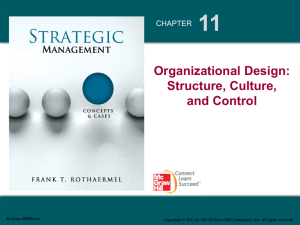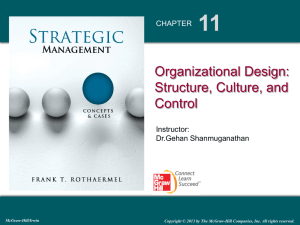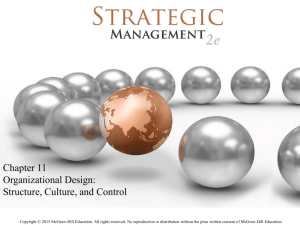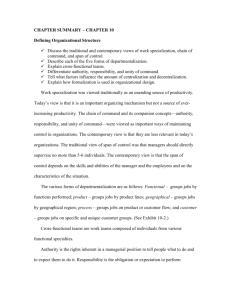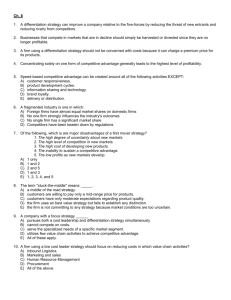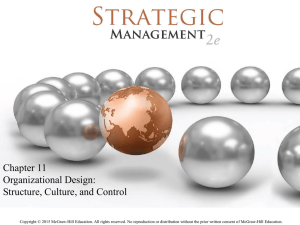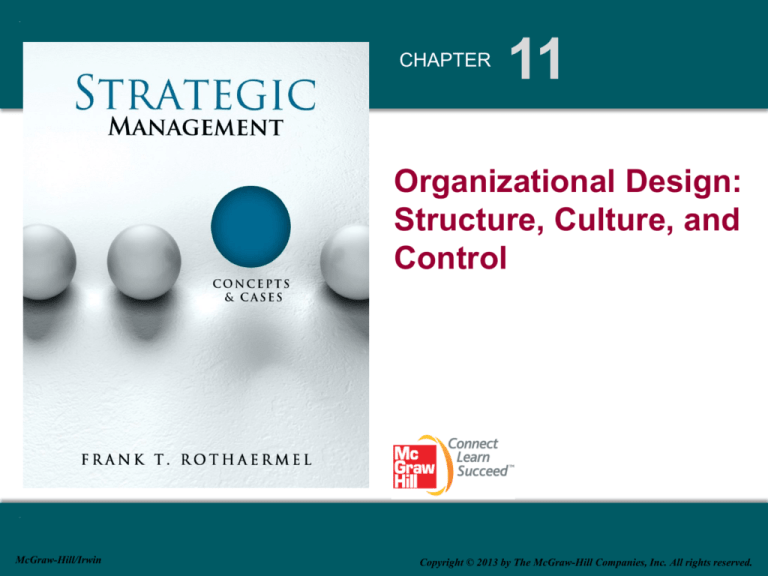
CHAPTER
11
Organizational Design:
Structure, Culture, and
Control
McGraw-Hill/Irwin
Copyright © 2013 by The McGraw-Hill Companies, Inc. All rights reserved.
Part 3 Strategy Implementation
Chapter Case 11
Zappos: An Organization Designed
to Deliver Happiness
• Zappos: Success through customer service
Customer service all in-house
No scripts or timed calls
• Flat Organizational Structure = Flexibility
Job rotation = trained talent
4 weeks of orientation training
Including 2 weeks on customer service phones.
EXHIBIT 11.1
Zappos’ Core Values
LO 11-1 Define organizational design and list its three
components.
LO 11-2 Explain how organizational inertia can lead established
firms to failure.
LO 11-3 Define organizational structure and describe its four elements.
LO 11-4 Compare and contrast mechanistic versus organic
organizations.
LO 11-5 Describe different organizational structures and match them
with appropriate strategies.
LO 11-6 Describe the elements of organizational culture and explain
where organizational cultures can come from the how they
can be changed.
LO 11-7 Compare and contrast different strategic control and reward
systems.
How to Organize for Competitive Advantage
• Organizational design
Goal is to translate strategies into realized ones
Structure
Processes
Procedures
• Structure follows strategies
Structure must be flexible
Yahoo failed to make changes to
their organizational structure.
Jerry Young ousted in 2008.
11-10
Sources of
Bureaucratic Costs
Number of
Middle
Managers
Motivational
Problems
Coordination
Problem
Information
Distortion
Bureaucratic
Costs
Copyright 1998 by Houghton Mifflin Company. All rights reserved.
Organizational Inertia and the Failure
of Established Firms
• Organizational inertia
Resistance to change
Often leads to failure because of the environmental
dynamics: competition, technology, strategy…etc.
• Organizational strategy and structure are not
static… But rather are dynamic!
• A tightly-coupled and coherent activity system that
works well in a static environment may be subject to
problems of inertia in a dynamic environment.
EXHIBIT 11.2
Organizational Inertia
LO 11-1 Define organizational design and list its three components.
LO 11-2 Explain how organizational inertia can lead established firms
to failure.
LO 11-3 Define organizational structure and describe its four
elements.
LO 11-4 Compare and contrast mechanistic versus organic
organizations.
LO 11-5 Describe different organizational structures and match them
with appropriate strategies.
LO 11-6 Describe the elements of organizational culture and explain
where organizational cultures can come from the how they
can be changed.
LO 11-7 Compare and contrast different strategic control and reward
systems.
The Key Elements of Organizational Structure
• Organizational structure determines
Work efforts of individuals and teams
Resource distribution
• Key building blocks
Specialization
Formalization
Centralization
Hierarchy
The Key Elements of Organizational Structure
• Specialization: degree to which a task is divided
Division of labor
Example: U.S. Military (Army, Air Force, Navy, Marines)
• Formalization: codified rules and formal procedures
Detailed written rules and policies
Examples: NASA, McDonald’s
The Key Elements of Organizational Structure
• Centralization: where the decision is made
Centralized decision making slow response time and
reduced customer satisfaction
Example: BP’s Mexican Gulf Oil Spill
• Hierarchy: formal, position-based reporting lines
Tall structure vs. flat structure
Tall structure higher degree of centralization
Flat structure lower degree of centralization
Span of control
STRATEGY HIGHLIGHT 11.2
W. L. Gore & Associates:
Informality and Innovation
• Bill Gore articulated 4 core values
Fairness to each other
Freedom to grow knowledge and skills
Ability to make one's own commitments
Consult with others before taking action
• W. L. Gore is organized in an informal and decentralized
manner
Empowered employees (no job titles, no job descriptions,
informal team organization, soft reporting lines)
Face-to-face communication
All associates are shareholders of the company
1–16
Assembling the Pieces:
Mechanistic vs. Organic Organizations
• Organic organizations
Low degree of specialization and formalization
Flat structure
Decentralized decision making
Uses virtual team due to information
technology
Examples: Zappos, W. L. Gore,
and many high-tech firms
• Mechanistic organizations
High degree of specialization and formalization
Tall hierarchy
Centralized decision making
Example: McDonald’s
Video on Web 2.0
Changing workplace
EXHIBIT 11.3
Mechanistic vs. Organic Organization
LO 11-1 Define organizational design and list its three components.
LO 11-2 Explain how organizational inertia can lead established firms to
failure.
LO 11-3 Define organizational structure and describe its four elements.
LO 11-4 Compare and contrast mechanistic versus organic organizations.
LO 11-5 Describe different organizational structures and match them
with appropriate strategies.
LO 11-6 Describe the elements of organizational culture and explain where
organizational cultures can come from the how they can be
changed.
LO 11-7 Compare and contrast different strategic control and reward
systems.
Matching Strategy and Structure
• Simple structure
Small firms with low complexity
Top management makes all important strategic decisions
Low degree of formalization and specialization
A basic organizational structure
Examples: small advertising, consulting, accounting, and law firms
EXHIBIT 11.4
Changing Organizational Structures and
Increasing Complexity as Firms Grow
Functional Structure
• Functional structure
Groups of employees with distinct functional areas
The areas of expertise correspond to distinct stages
in the company value chain activities
Example: College of Business, Finance Department , … etc.
• Recommended with narrow products/services
Matches well with business-level strategy
Cost leadership Mechanistic organization
Differentiation Organic organization
Integration strategy Ambidextrous organization
EXHIBIT 11.5
Typical Functional Structure
EXHIBIT 11.6
Matching Business Level Strategy and Structure
STRATEGY HIGHLIGHT 11.3
USA Today: Leveraging Ambidextrous
Organizational Design
• USA Today: one of the widest print circulations in U.S.
• USA Today.com, a new independent SBU under Gannett
• Although attracted readers and advertising dollars, USA
Today.com lost key editorial talent due to uneven resource
distribution
• Integration of USA Today and USA Today.com to eliminate
duplication of resources and reduce waste
1–25
Functional Strategy: Drawbacks
• Lacks effective communication channels
across departments
Lack of linkage between functions
Often solved the problems by having
cross-functional teams
• It cannot effectively address a higher level of
diversification
Multidivisional Structure
• Multidivisional structure
Consists of several distinct SBUs
Each SBU is operationally independent
Each leader of SBUs report to the corporate office
Examples:
Zappos is an SBU under Amazon
Skype is an SBU under Microsoft
Paypal is an SBU under eBay
Companies using M-form structure
GE, Honda
Organizing the Diversified Firm
• The multidivisional organization, as documented by
Alfred D. Chandler in Strategy and Structure, was
pioneered in the 1920s by pioneering firms such as:
DuPont, General Motors, Sears and Standard Oil;
By 1967, two-thirds of Fortune 500 Companies are
multidivisional.
Organizing the Diversified Firm
• Three key features of organizational structure:
1. The division of tasks;
2. The depth of the hierarchy (span of control);
3. The extent of authority delegation
(how much decentralization?)
EXHIBIT 11.7
Typical M-Form Structure
Functional Structure
Matrix Structure
Multidivisional Structure
• Use with various corporate strategies
• Related diversification
Co-opetition among SBUs
Transfer core competences across SBUs
Centralized decision making
• Unrelated diversification
Decentralized decision making
Competing for resources
EXHIBIT 11.8 Matching Corporate-Level Strategy
Evolutionary Stability of the Multidivisional Form
• Parable of the Two Watchmakers
10,000 parts
Watchmaker #1 needs to put all parts together or the watch falls
apart and he needs to start all over with his 10,000 parts.
Watchmaker #2 has developed 100 subsystems of 100 parts.
This is the “principle of near-decomposability” (I.e., a system that
contains localized sub-systems)
Evolutionary Stability of the Multidivisional Form
• Hierarchical systems (containing sub-systems)
will evolve much more rapidly from elementary
constituents than will non-hierarchic systems
containing the same number of elements.
• In organization theory this is called the effectiveness of
“loose coupling.”
The advantage of “loose coupling” is that if
there is poor performance in division 2 it
does not lead to failure of the entire system.
Effectiveness of Multidivisional Form
• Effective Divisionalization involves:
Identification of separable economic activities within
the firm;
Giving quasi-autonomous standing to each division
(usually of a profit center nature);
Monitoring the efficiency performance of each
division;
Awarding incentives;
Allocating cash flow to high yield uses; and
Performing strategic planning (diversification,
acquisition, and related activities)
Weaknesses of Multidivisional Form
• Dysfunctional Aspects of the Multidivisional:
Emphasis on short-term perspective;
Loss of economies of scope;
Duplication of R&D, marketing, etc.;
Emphasis on financial manipulation instead of
developing firm capabilities and resources; and
Large conglomerates may have excessive
political power.
11-19
Multidivisional Structure
Typical Chemical
Company
CEO
Corporate Headquarters Staff
Oil Division
(Functional
Structure)
Pharmaceuticals
Division (Product
Team Structure)
Plastics Division
(Matrix Structure)
Copyright 1998 by Houghton Mifflin Company. All rights reserved.
Matrix Structure
• A combination of functional and M-form structure
Creation of dual line of authority and reporting lines
Each SBU receives support both horizontally and
vertically
Very versatile
Enhanced learning from different SBUs
EXHIBIT 11.9
Typical (Global) Matrix Structure
EXHIBIT 11.10
Matching Global Strategy and Structure
LO 11-1 Define organizational design and list its three components.
LO 11-2 Explain how organizational inertia can lead established firms to
failure.
LO 11-3 Define organizational structure and describe its four elements.
LO 11-4 Compare and contrast mechanistic versus organic organizations.
LO 11-5 Describe different organizational structures and match them with
appropriate strategies.
LO 11-6 Describe the elements of organizational culture and explain
where organizational cultures can come from the how they can
be changed.
LO 11-7 Compare and contrast different strategic control and reward
systems.
Organizational Culture:
Values, Norms, and Artifacts
• Organizational culture
Collectively shared values and norms
Value: what is considered important
Norms: appropriate employee behaviors
and attitudes
Artifacts: expression of culture in items such as
physical design, stories, and celebrations
• Socialization
Internalize organization’s value and norms through
interactions
• Think of Zappos’ core values
• GM’s culture became strategic liability
Where Do Organizational Cultures Come From?
• Founder imprinting
Founders defined and shaped the culture
Apple (Steve Jobs)
Disney (Walt Disney)
Microsoft (Bill Gates)
• Wal-mart’s “low cost” culture by Sam Walton
• Recruit people that fit the culture
Zappos vs. GE
How Does Organizational Culture Change?
• Core competency core rigidity
Culture no longer has good fit with the environment
Cultural change is needed
• Cultural change
Brings new leadership
Mergers and acquisitions
Organizational Culture
• Culture must be valuable, rare, inimitable, and nonsubstitutable (RBV)
Causal ambiguity and social complexity
• Organizational culture is an important resource
Southwest Airlines
Friendly and energized employees work collaboratively
Zappos
Deliver WOW through service
STRATEGY HIGHLIGHT 11.4
Carly Fiorina at HP:
Cultural Change via Shock Therapy
• Carly Fiorina appointed CEO of HP in 1999
• Engineered acquisition of Compaq in 2002
• Carly Fiorina needed the acquisition to initiate structural and
cultural change in HP to overcome inertia
• Board of Directors fired her in 2005
Hired Mark Hurd who was himself fired in 2010…
• Continued turnover at top of HP; Mark Hurd was replaced by
Leo Apotheker, who in turn was replaced by Meg Whitman in
September 2011! (see Chapter Case 12).
1–51
Organizational Culture
• Cultural impact on employee behavior
Motivates employees by appealing to their ideas
Strengthen employee commitment, engagement, and
effort
• Culture is vital to an organization
Stronger founder imprinting leads to higher performance
Effective alignment allows development and refines
organizational core competency
How to Cut
Costs Video
LO 11-1 Define organizational design and list its three components.
LO 11-2 Explain how organizational inertia can lead established firms to
failure.
LO 11-3 Define organizational structure and describe its four elements.
LO 11-4 Compare and contrast mechanistic versus organic organizations.
LO 11-5 Describe different organizational structures and match them with
appropriate strategies.
LO 11-6 Describe the elements of organizational culture and explain where
organizational cultures can come from the how they can be
changed.
LO 11-7 Compare and contrast different strategic control and
reward systems.
Strategic Control and Reward Systems
• Internal governance mechanisms
Culture
Sanctions
• Input controls
Rules and standard operating procedures
Budgets
Behavior guidelines
• Output controls
Result-oriented
ROWEs (results only work environment)
Dan Pink’s
RSA Video
Take-Away Concepts
LO 11-1 Define organizational design and list its three components.
Organizational design is the process of creating, implementing, monitoring,
and modifying the structure, process, and procedures of an organization.
The key components of organizational design are structure, culture, and
control.
The goal is to design an organization that allows mangers to effectively
translate their chosen strategy into a realized one.
LO 11-2 Explain how organizational inertia can lead to the failure of established
firms.
Organizational inertia can lead to the failure of established firms when a
tightly coupled system of strategy and structure experiences internal or
external shifts.
Firm failure happens through a dynamic, four-step process (see Exhibit
11.2).
Take-Away Concepts
LO 11-3 Define organizational structure and describe its four elements.
An organizational structure determines how firms orchestrate employees’ work
efforts and distribute resources. It defines how firms divide and integrate tasks,
delineates the reporting relationships up and down the hierarchy, defines formal
communication channels, and prescribes how employees coordinate work efforts.
The four building blocks of an organizational structure are specialization,
formalization, centralization, and hierarchy (see Exhibit 11.3).
LO 11-4 Compare and contrast mechanistic versus organic organizations.
Organic organizations are characterized by a low degree of specialization and
formalization, a flat organizational structure, and decentralized decision making.
Mechanistic organizations are described by a high degree of specialization and
formalization, and a tall hierarchy that relies on centralized decision making.
The comparative effectiveness of mechanistic versus organic organizational
forms depends on the context.
Take-Away Concepts
LO 11-5 Describe different organizational structures and match them with appropriate
strategies.
To gain and sustain competitive advantage, not only must structure follow
strategy, but also the chosen organizational form must match the firm’s business
strategy.
The strategy–structure relationship is dynamic, changing in a predictable
pattern – from simple to functional structure, then to multidivisional (M-form) and
matrix structure – as firms grow in size and complexity.
In a simple structure, the founder tends to make all the important strategic
decisions as well as run the day-to-day operations.
A functional structure groups employees into distinct functional areas based on
domain expertise. Its different variations are matched with different business
strategies: cost-leadership, differentiation, and integration (see Exhibit 11.6).
The multidivisional (M-form) structure consists of several distinct SBUs, each
with its own profit-and-loss responsibility. Each SBU operates more or less
independently from one another, led by a CEO responsible for the business
strategy or the unit and its day-to-day operations (see Exhibit 11.7).
Take-Away Concepts
LO 11-5 Describe different organizational structures and match them with
appropriate strategies.
The matrix structure is a mixture of two organizational forms: the M-form
and the functional structure (see Exhibit 11.10).
Exhibits 11.8 and 11.10 show how best to match different corporate and
global strategies with respective organizational structures.
LO 11-6 Describe the elements of organizational culture, and explain where
organizational cultures can come from and how they can be changed.
Organizational culture describes the collectively shared values and norms of
its members.
Values define what is considered important, and norms define appropriate
employee attitudes and behaviors.
Corporate culture finds its expression in artifacts, which are observable
expressions of an organization’s culture.
Take-Away Concepts
LO 11-7 Compare and contrast different strategic control and reward systems.
Strategic control and reward systems are internal governance mechanisms
put in place to align the incentives of principals (shareholders) and agents
(employees).
Strategic control and reward systems allow managers to specify goals,
measure progress, and provide performance feedback.
Besides the balanced-scorecard framework, managers can use
organizational culture, input controls, and output controls as part of the
firm’s strategic control and reward systems.
Input controls define and direct employee behavior through explicit and
codified rules and standard operating procedures.
Output control guides employee behavior by defining expected results, but
leaves the means to those results open to individual employees, groups, or
SBUs.

